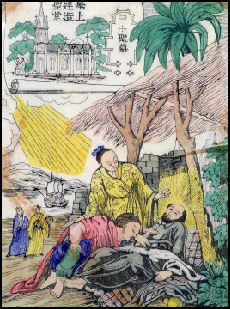Japan has repulsed two cultures that clashed with her Culture. First she pushed back against Christian proselytizing and then Islam.
There have been no Islamic terrorist attacks in Japan. It is suggested it is because of its policy of Sakoku (鎖国), a closed door policy to foreigners, the immigration policy enacted by the Tokugawa Shogunate,
Japan was built on social policies reflecting the ideology of neo-Confucianism (the establishment of human doctrines and ritual necessary to maintaining familial and social relationships). Under the Tokugawa regime from 1603 until 1868 “the social structure was organized around principles of hierarchy, centralized authority, and collective responsibility. The individual was subordinated to the specific obligations of their ascribed social roles, and virtue consisted of perfecting one’s ability to fit the requirements of one’s role. In the upper reaches of society, the kinship system upheld neo-Confucianism promoting family as a microcosm of the social order under a rigid system of ranked social classes: warriors, peasants, artisans, and merchants. Status reflected ideals of social utility, not wealth.”
Christianity attempted to spread the Gospel in Japan in the mid-sixteenth century. Francis Xavier arrived with Christian missionaries and the Jesuits in the 1540s and briefly flourished, converting more than 100,000 Japanese including many on the island of Kyushu. Xavier was disheartened within a few years and called Japanese Buddhism (similar in values with Confucianism) “an invention of the devil.”

St. Francis Xavier
From the 1560’s to the 1580’s Christianity grew, sometimes by force. In 1574 Buddhist temples and Shinto shrines were burned or demolished throughout the Omura domain in Kyushu; 60,000 subjects were baptized, often by force. By 1582, there were 200 churches serving an estimated 150,000 Christians.
By the early 1600’s Japan had had enough. Christianity was viewed as a threat to national unity.
Toyotomi Hideyoshi, Japan’s most powerful warlord, wary of these “foreigners” and their imperialism, sent an invasion force of 250,000 to the island of Kyushu, November 1586. When he was done he ordered the expulsion of all Christian missionaries from the island. In 1587 Hideyoshi banned all Jesuit missionaries. At Nagasaki he had 26 Christians, 17 of them Japanese, crucified.
The next 40 years saw the wholesale slaughter of Christians throughout Japan. A typical scene was witnessed by the English trader Richard Cox in 1619: “Fifty-five persons of all ages and both sexes were burnt alive on the dry bed of the Kamo River in Kyoto, among them little children of 5 or 6 years old in their mothers’ arms, crying out ‘Jesus, receive their souls!’”
Engelbert Kaempfer, stationed at Nagasaki with the Dutch East India Company wrote that he saw “the most cruel persecution and torture of Christians ever witnessed on this globe.”
The “evil sect” — Hideyoshi’s words — never recovered.
Today, Islam is spreading around the world. In Japan with a population of 127,000,000 people there are less than 100,000 Muslims, and 80 Mosques. Approximately 10 percent of Muslims in Japan are local converts, the other 90% are foreign nationals. “The Japanese attitude toward Japanese Muslims is probably a bit different from their attitude toward non-Muslims. This is rooted in the fact that there are rather heavy cultural expectations that all Japanese must bear. Islamic prohibitions on alcohol and pork can easily conflict with Japanese expectations.”
Muslims in Japanese society are treated with the same respect or “similar form of discrimination” as other foreigners. But there is a lack of tolerance, for want of a better word, towards Muslims who bring their religion into the public square and work. They will face “cultural barriers.” Devout Muslims who request prayer five times a day will not find work.Women in hijabs are not always able to find work either. In Japan Muslims “collect” prayers that have been missed during certain parts of the day or night.
There is surveillance of the Muslim population. Extreme. In 2010 police compiled detailed profiles on 72,000 Muslims, including personal information such as bank account statements, passport details and records of their movements.
In 2015 the Islamic State beheaded Japanese hostages. “I feel intense indignation at this utterly cruel and despicable act of terrorism. I will never forgive these terrorists,” Prime Minister Abe said. “Japan will work with the international community to bring those responsible for this crime to justice. Japan will never give in to terrorism.”
It is no easy feat to gain Japanese citizenship. The authorities have broad discretion. There is a great emphasis on the ability to speak Japanese. One must live in Japan five years before applying for citizenship and one of the most important factors is the ability to assimilate. These attitudes are far different from those in most western developed countries.The attitude seems to be one of “fences make for great neighbours.”
The concepts of tolerance and accommodation in Japan, now primarily a Buddhist and Shinto country, are understood differently than they are in Europe, Canada and the USA. In Japan “foreigners” accommodate to the Japanese culture-not the other way around. And tolerance is required of the other, not the Japanese.
I suppose we will never know for sure why Muslim terrorism is not a threat in Japan. It could be that Japan does not cater to foreign cultures.
copyright dianebederman.com 2016


